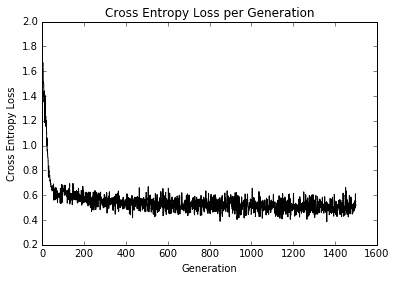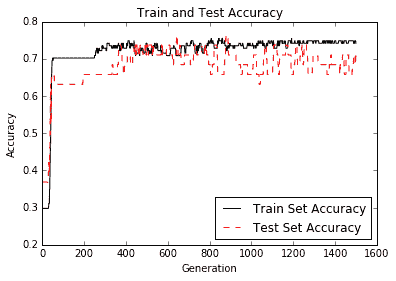# 改進線性模型的預測
在前面的秘籍中,我們注意到我們擬合的參數數量遠遠超過等效的線性模型。在這個秘籍中,我們將嘗試通過使用神經網絡來改進我們的低出生體重的邏輯模型。
## 做好準備
對于這個秘籍,我們將加載低出生體重數據,并使用神經網絡與兩個隱藏的完全連接的層與乙狀結腸激活,以適應低出生體重的概率。
## 怎么做
我們按如下方式處理秘籍:
1. 我們首先加載庫并初始化我們的計算圖,如下所示:
```py
import matplotlib.pyplot as plt
import numpy as np
import tensorflow as tf
import requests
sess = tf.Session()
```
1. 接下來,我們按照前面的秘籍加載,提取和標準化我們的數據,除了在這里我們將使用低出生體重指示變量作為我們的目標而不是實際出生體重,如下所示:
```py
# Name of data file
birth_weight_file = 'birth_weight.csv'
birthdata_url = 'https://github.com/nfmcclure/tensorflow_cookbook/raw/master' \
'/01_Introduction/07_Working_with_Data_Sources/birthweight_data/birthweight.dat'
# Download data and create data file if file does not exist in current directory
if not os.path.exists(birth_weight_file):
birth_file = requests.get(birthdata_url)
birth_data = birth_file.text.split('\r\n')
birth_header = birth_data[0].split('\t')
birth_data = [[float(x) for x in y.split('\t') if len(x) >= 1]
for y in birth_data[1:] if len(y) >= 1]
with open(birth_weight_file, "w") as f:
writer = csv.writer(f)
writer.writerows([birth_header])
writer.writerows(birth_data)
# read birth weight data into memory
birth_data = []
with open(birth_weight_file, newline='') as csvfile:
csv_reader = csv.reader(csvfile)
birth_header = next(csv_reader)
for row in csv_reader:
birth_data.append(row)
birth_data = [[float(x) for x in row] for row in birth_data]
# Pull out target variable
y_vals = np.array([x[0] for x in birth_data])
# Pull out predictor variables (not id, not target, and not birthweight)
x_vals = np.array([x[1:8] for x in birth_data])
train_indices = np.random.choice(len(x_vals), round(len(x_vals)*0.8), replace=False)
test_indices = np.array(list(set(range(len(x_vals))) - set(train_indices)))
x_vals_train = x_vals[train_indices]
x_vals_test = x_vals[test_indices]
y_vals_train = y_vals[train_indices]
y_vals_test = y_vals[test_indices]
def normalize_cols(m, col_min=np.array([None]), col_max=np.array([None])):
if not col_min[0]:
col_min = m.min(axis=0)
if not col_max[0]:
col_max = m.max(axis=0)
return (m - col_min) / (col_max - col_min), col_min, col_max
x_vals_train, train_min, train_max = np.nan_to_num(normalize_cols(x_vals_train))
x_vals_test, _, _ = np.nan_to_num(normalize_cols(x_vals_test, train_min, train_max))
```
1. 接下來,我們需要聲明我們的批量大小和數據的占位符,如下所示:
```py
batch_size = 90
x_data = tf.placeholder(shape=[None, 7], dtype=tf.float32)
y_target = tf.placeholder(shape=[None, 1], dtype=tf.float32)
```
1. 如前所述,我們現在需要聲明在模型中初始化變量和層的函數。為了創建更好的邏輯函數,我們需要創建一個在輸入層上返回邏輯層的函數。換句話說,我們將使用完全連接的層并為每個層返回一個 sigmoid 元素。重要的是要記住我們的損失函數將包含最終的 sigmoid,因此我們要在最后一層指定我們不會返回輸出的 sigmoid,如下所示:
```py
def init_variable(shape):
return tf.Variable(tf.random_normal(shape=shape))
# Create a logistic layer definition
def logistic(input_layer, multiplication_weight, bias_weight, activation = True):
linear_layer = tf.add(tf.matmul(input_layer, multiplication_weight), bias_weight)
if activation:
return tf.nn.sigmoid(linear_layer)
else:
return linear_layer
```
1. 現在我們將聲明三個層(兩個隱藏層和一個輸出層)。我們將首先為每個層初始化權重和偏差矩陣,并按如下方式定義層操作:
```py
# First logistic layer (7 inputs to 14 hidden nodes)
A1 = init_variable(shape=[7,14])
b1 = init_variable(shape=[14])
logistic_layer1 = logistic(x_data, A1, b1)
# Second logistic layer (14 hidden inputs to 5 hidden nodes)
A2 = init_variable(shape=[14,5])
b2 = init_variable(shape=[5])
logistic_layer2 = logistic(logistic_layer1, A2, b2)
# Final output layer (5 hidden nodes to 1 output)
A3 = init_variable(shape=[5,1])
b3 = init_variable(shape=[1])
final_output = logistic(logistic_layer2, A3, b3, activation=False)
```
1. 接下來,我們聲明我們的損失(交叉熵)和優化算法,并初始化以下變量:
```py
# Create loss function
loss = tf.reduce_mean(tf.nn.sigmoid_cross_entropy_with_logits(logits=final_output, labels=y_target))
# Declare optimizer
my_opt = tf.train.AdamOptimizer(learning_rate = 0.002)
train_step = my_opt.minimize(loss)
# Initialize variables
init = tf.global_variables_initializer()
sess.run(init)
```
> 交叉熵是一種測量概率之間距離的方法。在這里,我們想要測量確定性(0 或 1)與模型概率(`0<x<1`)之間的差異。 TensorFlow 使用內置的 sigmoid 函數實現交叉熵。這也是超參數調整的一部分,因為我們更有可能找到最佳的損失函數,學習率和針對當前問題的優化算法。為簡潔起見,我們不包括超參數調整。
1. 為了評估和比較我們的模型與以前的模型,我們需要在圖上創建預測和精度操作。這將允許我們提供整個測試集并確定準確率,如下所示:
```py
prediction = tf.round(tf.nn.sigmoid(final_output))
predictions_correct = tf.cast(tf.equal(prediction, y_target), tf.float32)
accuracy = tf.reduce_mean(predictions_correct)
```
1. 我們現在準備開始我們的訓練循環。我們將訓練 1500 代并保存模型損失并訓練和測試精度以便以后進行繪圖。我們的訓練循環使用以下代碼啟動:
```py
# Initialize loss and accuracy vectors loss_vec = [] train_acc = [] test_acc = []
for i in range(1500):
# Select random indicies for batch selection
rand_index = np.random.choice(len(x_vals_train), size=batch_size)
# Select batch
rand_x = x_vals_train[rand_index]
rand_y = np.transpose([y_vals_train[rand_index]])
# Run training step
sess.run(train_step, feed_dict={x_data: rand_x, y_target: rand_y})
# Get training loss
temp_loss = sess.run(loss, feed_dict={x_data: rand_x, y_target: rand_y})
loss_vec.append(temp_loss)
# Get training accuracy
temp_acc_train = sess.run(accuracy, feed_dict={x_data: x_vals_train, y_target: np.transpose([y_vals_train])})
train_acc.append(temp_acc_train)
# Get test accuracy
temp_acc_test = sess.run(accuracy, feed_dict={x_data: x_vals_test, y_target: np.transpose([y_vals_test])})
test_acc.append(temp_acc_test)
if (i+1)%150==0:
print('Loss = '' + str(temp_loss))
```
1. 上一步應該產生以下輸出:
```py
Loss = 0.696393
Loss = 0.591708
Loss = 0.59214
Loss = 0.505553
Loss = 0.541974
Loss = 0.512707
Loss = 0.590149
Loss = 0.502641
Loss = 0.518047
Loss = 0.502616
```
1. 以下代碼塊說明了如何使用`matplotlib`繪制交叉熵損失以及訓練和測試集精度:
```py
# Plot loss over time
plt.plot(loss_vec, 'k-')
plt.title('Cross Entropy Loss per Generation')
plt.xlabel('Generation')
plt.ylabel('Cross Entropy Loss')
plt.show()
# Plot train and test accuracy
plt.plot(train_acc, 'k-', label='Train Set Accuracy')
plt.plot(test_acc, 'r--', label='Test Set Accuracy')
plt.title('Train and Test Accuracy')
plt.xlabel('Generation')
plt.ylabel('Accuracy')
plt.legend(loc='lower right')
plt.show()
```
我們得到每代交叉熵損失的圖如下:

圖 7:超過 1500 次迭代的訓練損失
在大約 50 代之內,我們已經達到了良好的模式。在我們繼續訓練時,我們可以看到在剩余的迭代中獲得的很少,如下圖所示:

圖 8:訓練組和測試裝置的準確率
正如您在上圖中所看到的,我們很快就找到了一個好模型。
## 工作原理
在考慮使用神經網絡建模數據時,您必須考慮優缺點。雖然我們的模型比以前的模型融合得更快,并且可能具有更高的準確率,但這需要付出代價;我們正在訓練更多的模型變量,并且更有可能過擬合。為了檢查是否發生過擬合,我們會查看測試和訓練集的準確率。如果訓練集的準確率繼續增加而測試集的精度保持不變或甚至略微下降,我們可以假設過擬合正在發生。
為了對抗欠擬合,我們可以增加模型深度或訓練模型以進行更多迭代。為了解決過擬合問題,我們可以為模型添加更多數據或添加正則化技術。
同樣重要的是要注意我們的模型變量不像線性模型那樣可解釋。神經網絡模型具有比線性模型更難解釋的系數,因為它們解釋了模型中特征的重要性。
- TensorFlow 入門
- 介紹
- TensorFlow 如何工作
- 聲明變量和張量
- 使用占位符和變量
- 使用矩陣
- 聲明操作符
- 實現激活函數
- 使用數據源
- 其他資源
- TensorFlow 的方式
- 介紹
- 計算圖中的操作
- 對嵌套操作分層
- 使用多個層
- 實現損失函數
- 實現反向傳播
- 使用批量和隨機訓練
- 把所有東西結合在一起
- 評估模型
- 線性回歸
- 介紹
- 使用矩陣逆方法
- 實現分解方法
- 學習 TensorFlow 線性回歸方法
- 理解線性回歸中的損失函數
- 實現 deming 回歸
- 實現套索和嶺回歸
- 實現彈性網絡回歸
- 實現邏輯回歸
- 支持向量機
- 介紹
- 使用線性 SVM
- 簡化為線性回歸
- 在 TensorFlow 中使用內核
- 實現非線性 SVM
- 實現多類 SVM
- 最近鄰方法
- 介紹
- 使用最近鄰
- 使用基于文本的距離
- 使用混合距離函數的計算
- 使用地址匹配的示例
- 使用最近鄰進行圖像識別
- 神經網絡
- 介紹
- 實現操作門
- 使用門和激活函數
- 實現單層神經網絡
- 實現不同的層
- 使用多層神經網絡
- 改進線性模型的預測
- 學習玩井字棋
- 自然語言處理
- 介紹
- 使用詞袋嵌入
- 實現 TF-IDF
- 使用 Skip-Gram 嵌入
- 使用 CBOW 嵌入
- 使用 word2vec 進行預測
- 使用 doc2vec 進行情緒分析
- 卷積神經網絡
- 介紹
- 實現簡單的 CNN
- 實現先進的 CNN
- 重新訓練現有的 CNN 模型
- 應用 StyleNet 和 NeuralStyle 項目
- 實現 DeepDream
- 循環神經網絡
- 介紹
- 為垃圾郵件預測實現 RNN
- 實現 LSTM 模型
- 堆疊多個 LSTM 層
- 創建序列到序列模型
- 訓練 Siamese RNN 相似性度量
- 將 TensorFlow 投入生產
- 介紹
- 實現單元測試
- 使用多個執行程序
- 并行化 TensorFlow
- 將 TensorFlow 投入生產
- 生產環境 TensorFlow 的一個例子
- 使用 TensorFlow 服務
- 更多 TensorFlow
- 介紹
- 可視化 TensorBoard 中的圖
- 使用遺傳算法
- 使用 k 均值聚類
- 求解常微分方程組
- 使用隨機森林
- 使用 TensorFlow 和 Keras
